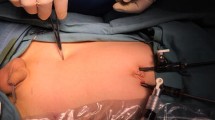Abstract
Background
In many centers in sub-Saharan Africa, adults and children aged over 12 years with indirect inguinal hernias are treated with Bassini’s herniorrhaphy with many avoidable complications. The objective of this study was to determine the applicability of herniotomy in patients aged between 12 and 45 years.
Methods
A prospective study was carried out on patients aged between 12 and 45 years with indirect inguinal hernias who were treated with herniotomy at the Leadeks Medical Center, Benin City, Nigeria, between January 2002 and December 2007.
Results
A total of 316 patients aged between 12 and 45 years (mean 25 ± 5.3 years), comprising 305 males and 11 females with a male:female ratio of 27.7:1, had 326 herniotomies, which accounted for 27.5% of pediatric operations during the study period. Two hundred and eighty-three (86.8%) patients had elective while 43 (13.2%) had emergency surgery following features of obstruction and strangulation, with a mean duration of surgery of 30 min (range 20–40 min). All of the patients were operated on day case with a mean observation period of 8 ± 3.5 h (range 2–24 h), and no significant immediate postoperative complication was recorded. Postoperative pain was extremely statistically significant in those cases that had strangulation before operation (P < 0.0001), but paracetamol was an adequate analgesia. The patients resumed normal duties between 5 and 14 days after repair and have been followed up for 1–5 years, with one (0.3%) patient, who was also being treated for chronic cough, who had recurrence 3 years after operation.
Conclusion
Herniotomy was found to be safe, applicable, beneficial, and cost-effective in this age group, with many advantages over Bassini’s herniorrhaphy.
Similar content being viewed by others
References
Lau WY (2002) History of treatment of groin hernia. World J Surg 26:748–759
Mokete M, Earnshaw JJ (2001) Evolution of an inguinal hernia surgery practice. Postgrad Med J 77:188–190
Okunribido O, Ladipo JK, Ajao OG (1992) Inguinal hernia in paediatric age-group: Ibadan experience. East Afr Med J 69:347–348
Awojobi OA, Ayantude AA (2004) Inguinal hernia in Nigeria. Trop Doct 34:180–181
Adesunkanmi ARK, Badmus TA, Ogundoyin O (2004) Determinants of outcome of inguinal herniorrhaphy in Nigerian patients. Ann Coll Surg Hong Kong 8:14–21
Poobalan AS, Bruce J, Smith WC, King PM, Krukowski ZH, Chambers WA (2003) A review of chronic pain after inguinal herniorrhaphy. Clin J Pain 19:48–54
Bay-Nielson M, Thomsen H, Andersen FH, Bendix JH, Sørensen OK, Skovgaard N, Kehlet H (2004) Convalescence after inguinal herniorrhaphy. Br J Surg 91:362–367
Liem MS, van Duyn EB, van der Graaf Y, van Vroonhoven TJ (2003) Recurrence after conventional anterior and laparoscopic inguinal hernia repair—a randomized comparison. Ann Surg 237:136–141
Voyles CR (2003) Outcomes analysis for groin hernia repairs. Surg Clin North Am 83:1279–1287
Elechi EN (1987) External abdominal wall hernias: experience with elective and emergency repairs in Nigeria. Br J Surg 74:834–835
Surgery in Africa discussion group (2006) What is the most appropriate repair for groin hernias in Africa? In: Surgery in Africa—monthly review. Available online at: http://www.ptolemy.ca/members/archives/2005/Groin_Hernias_August_2005.pdf
Nathan JD, Pappas TN (2003) Inguinal hernia: an old condition with new solutions. Ann Surg 238:S148–S157
Mayagoitia JC (2004) Inguinal hernioplasty with the Prolene Hernia System. Hernia 8:64–66
Kugel RD (1999) Minimally invasive, nonlaparoscopic, preperitoneal, and sutureless, inguinal herniorrhaphy. Am J Surg 178:298–302
Nordin P, Haapaniemi S, Kald A, Nilsson E (2003) Influence of suture material and surgical technique on risk of reoperation after non-mesh open hernia repair. Br J Surg 90:1004–1008
Abantanga FA (2003) Groin and scrotal swellings in children aged 5 years and below: a review of 535 cases. Pediatr Surg Int 19:446–450
Paxton G, Hutson JM, Hasthorpe S (1999) Age distribution of inguinal hernia fusion in vitro. Hernia 3:175–180
Ohene-Yeboah M (2003) Strangulated external hernias in Kumasi. West Afr J Med 22:310–313
McConkey SJ (2002) Case series of acute abdominal surgery in rural Sierra Leone. World J Surg 26:509–513
Odula PO, Kakande I (2004) Groin hernia in Mulago Hospital, Kampala. East Central Afr J Surg 9:48–52
Stephenson BM (2003) Complications of open groin hernia repairs. Surg Clin North Am 83:1255–1278
Ramyil VM, Iya D, Ogbonna BC, Dakum NK (2000) Safety of daycare hernia repair in Jos, Nigeria. East Afr Med J 77:326–328
Irabor DO (2005) Hernia repair under local or intravenous ketamine in a tropical low socio-economic population. West Afr J Med 24:143–146
Sanchez-Manuel FJ, Seco-Gil JL (2007) Antibiotic prophylaxis for hernia repair. Cochrane Database Syst Rev, issue 3, art. no. CD003769. doi:10.1002/14651858.CD003769.pub3
Feliu X, Jaurrieta E, Viñas X, Macarulla E, Abad JM, Fernández-Sallent E (2004) Recurrent inguinal hernia: a ten-year review. J Laparoendosc Adv Surg Tech A 14:362–367
Author information
Authors and Affiliations
Corresponding author
Rights and permissions
About this article
Cite this article
Osifo, O.D., Irowa, O.O. Indirect inguinal hernia in Nigerian older children and young adults: is herniorrhaphy necessary?. Hernia 12, 635–639 (2008). https://doi.org/10.1007/s10029-008-0402-0
Received:
Accepted:
Published:
Issue Date:
DOI: https://doi.org/10.1007/s10029-008-0402-0




